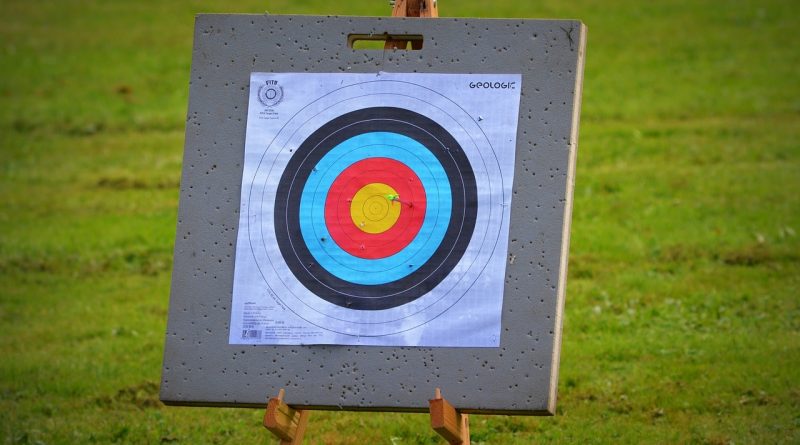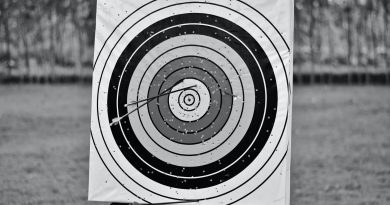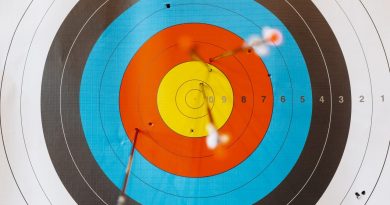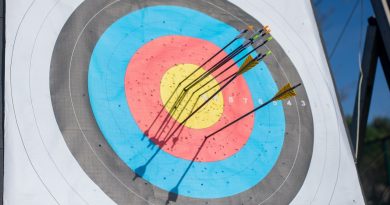Novelty Shoots
Monotony probably drives more archers into retirement than age or any other factor. Over the years, a surprisingly large number of archers who do not hunt have laid aside the bow because of lack of variety in the shoots conducted by their local clubs. When a club offers nothing but the opportunity to acquire an A rating and planning is directed solely to that end, the average bowman loses interest in tramping the same course and shooting at the same targets day after day with the only objective the possibility of picking up a few more points to increase the total score for the round. The unvaried sameness of target shooting dulls an archer’s interest in an even shorter length of time.
To most of us an A rating in either target or field archery is beyond our reach, and so we tire of the same old grind and quietly drop out of the picture, leaving the field to those who would be champions and to whom all else is of no importance. As a result, the turnover in club membership is entirely too high and serious thought should be given to develop a varied program of club activities which will contain attractive features for all classes of shooters and every member of the family. A sport which has been highly recommended for all members of the family has suddenly gone sour and we are at a loss to know exactly what has happened.
To run a successful club, to hold and to increase the membership, club officials must revise their thinking. The important unit in a successful archery club is the family, and all club activities should be planned with the entertainment of the family the primary objective. In these days of high prices, cost of entertainment can take a large bite out of the average budget. Archery is a relatively inexpensive sport and one in which all members of the family can participate as a group. A club which plans a broad program with activities which take in even the non-shooting members of the family need never lack members.
Perhaps we would inconvenience a few hot-shots, but lets stop shoving the ladies and the juniors into the background. As one innovation we can have the family shoot as a team in a club shoot. Improvise a little and interest in shooting will show a decided improvement. Any father will get a lot of pleasure from shooting the course in company with his family. Combine the scores of the individual members of the family team and divide the total by the number of members in the family to get a “Family Score” for the round.
Shooting on a target range or the same units of a field course time after time is not a fair measure of a bowman’s skill regardless of his score. Listen to the “expert” alibi a low score when he shoots on a strange course and you have a fair idea of what happens when the archer gets away from the same old rounds which he has been shooting, due to lack of imagination on the part of those who are planning the activities.
Several novelty targets which provide plenty of fun for both novice and expert can be substituted for the regular targets. The new round can consist entirely of this type of target or they can be substituted for certain of the targets at intervals throughout the course. A sporting goods merchant sponsored one of these shoots at the regular monthly meeting of the local Fish and Game Club in a nearby town. The shoot, followed by a movie on archery in the club house, was well attended. Prizes for the winners, and food for both spectators and participants alike, were provided by the merchant. Visitors were welcome and no charge was made for registration. The winner was a free-style shooter who used a sight and shot a score of twenty-three out of a possible fifty. All targets were shot at unknown distances.
Five novelty targets comprised the round and the scoring was a variation of the method used in the regulation Broad-head Round.
1st arrow a hit 5 points
2nd arrow a hit 3 points
3rd arrow a hit 1 point
If an archer scored with the first arrow, he did not shoot the other two. If he scored with the second arrow he did not shoot the third.
Target No. 1 – Twenty Yards. This target consisted of two eight inch diameter balloons, each suspended from a string thirty-six inches in length. They were pinned to one of the practice butts and a light breeze kept the balloons in motion.
Target No. 2 – Thirty Yards. Three life size crows made from light plywood. They were placed on a replica of a three strand wire fence, one on each wire, staggered so that they were not directly one above the other. A strip of wood about one-half inch square was nailed to the back of each crow at approximately the mid-section and a one and one-half inch square block of inch thick wood was nailed back of the tip of the tail. With the tail weighted in this manner the crow will sit on the wire and a hit will knock it to the ground.
Target No. 3 – Fifteen Yards. This target consisted of a regulation clay bird used in trap and skeet shooting which was held in a wire rig made from a coat hanger and bent in the form of a pendulum eighteen inches in length. The pendulum was suspended from an arrow shaft inserted horizontally into a straw butt. For each shot the clay bird was raised to the nine o’clock position and released. Nice timing will break the clay bird as it swings in its arc. This provides quite a kick if you have never tried this stunt.
Target No. 4 – Forty Yards. A running deer silhouette. The construction of this target is fully described in Chapter 14, Moving Targets. A paper target of a running deer can be tacked to the face of the target. The attendant on this target, as a safety measure, should pull the target back to the starting point by walking away from the target. Use the monkey line attached to the target for this purpose. Under no circumstances should the attendant pull the target back to the starting post hand over hand. To stand at the starting post is extremely dangerous as the archers will come to full draw before the target starts its run and an arrow could slip from the shooter’s fingers accidently striking the attendant.
Target No. 5 – Eighty-five to Ninety Yards. A standard forty-eight inch circular paper target face is pinned on a straw butt located between eighty-five and ninety yards from the shooting peg. An arrow striking any part of the target face inside the outer black line shall constitute a hit. It is not unusual for an expert target archer to underestimate the distance to such a target by as much as twenty percent. Scores of all contestants improved the second time they shot around the prescribed layout.
To set up the layout, prepare the numerals one to five inclusive, ten inches high, black lettering on a white cardboard background. Pin the numerals on the target butts to indicate the order in which the course is to be shot. Make five shooting pegs from i by 2 inch material eighteen inches in length. Paint the upper 9 inches white and number the pegs from 1 to 5 inclusive to mark the shooting position for the corresponding numbered target. Choose the location of the targets carefully so that the participants will not have to walk along or cross the line of flight of any target when it is in use. Make provisions for spectators so that they will not be endangered. A field captain should be appointed to control the shoot and no practice should be permitted prior to the competition on the novelty targets. High angle shots at flying targets have not been included in this layout as they offer little chance for a hit to the ordinary bowman and too much time is wasted retrieving arrows. Arrows fletched especially for this type of shooting are not ordinarily carried in the archer’s quiver.
Prior to the institution of the forty hour work week, little leisure time was available to the ordinary individual except Sunday. The practice of holding tournaments on Sunday was customary in the past and has been carried over to a large extent to the present day. Starting time is generally set for 10:00 a.m. It has become increasingly evident that numbers of our people do not attend these Sunday tournaments because they conflict with morning church services. Recently some of the newly organized archery federations have wisely voted to start all Sunday tournaments at 2:00 p.m. Daylight saving time and the long summer evenings provide plenty of time for completion of the standard target and field rounds. This leaves the mornings free for the archer to attend the church of his choice. The practice is recommended to clubs who would like to increase attendance at their Sunday tournaments.




